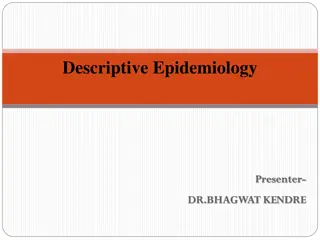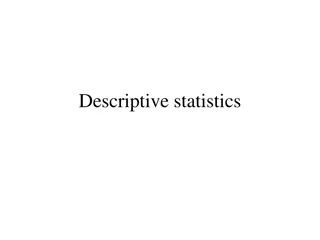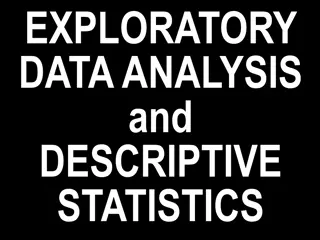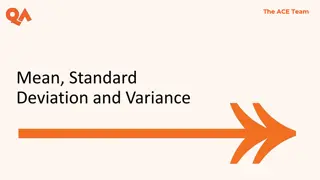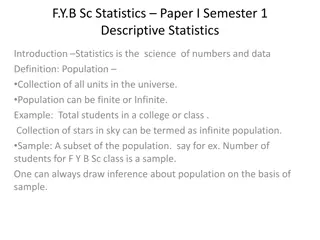Understanding Descriptive Statistics in AP Biology
Descriptive statistics play a crucial role in analyzing and interpreting data in AP Biology. They include mean, sample size, standard deviation, and standard error, helping researchers arrive at conclusions, support arguments, and communicate findings effectively. Knowing how to calculate and interpret these statistics is essential for making reliable scientific claims and understanding the reliability of data in biological research.
Download Presentation

Please find below an Image/Link to download the presentation.
The content on the website is provided AS IS for your information and personal use only. It may not be sold, licensed, or shared on other websites without obtaining consent from the author. Download presentation by click this link. If you encounter any issues during the download, it is possible that the publisher has removed the file from their server.
E N D
Presentation Transcript
Stats for AP Biology SLIDE SHOWS MODIFIED FROM: http://apbiowarde.weebly.com/uploads/3/8/3/0/38303939/stats_pp.pptx https://www.google.com/url?sa=t&rct=j&q=&esrc=s&source=web&cd=2&cad=rja&uact=8&ved=0ahUKEwiBgJ6ntcTXAhWHTSYKHUT_DWAQFggvMAE&ur l=http%3A%2F%2Fwww.bville.org%2Ftfiles%2Ffolder427%2Fap_standard_deviation_and_standard_error.pptx&usg=AOvVaw3J7ssjoCq2jMZGlQ3dcAmW
Bozeman Biology videos: AP Science Practice 2: Using Math Appropriately Statistics for Science Standard Deviation Standard Error Modified from: Mathisfun.com http://www.mathsisfun.com/data/standard-deviation.html
Data analysis allows you to Arrive at conclusions about your data Make claims about your data Support arguments using your data Estimate the reliability of your data Effectively communicate conclusions about your work to a larger scientific community
Appropriate descriptive statistics for a data set typically include: Mean (average) Sample size Standard deviation Standard error
Mean (average) Sum of the numbers in the sample divided by the total number in the sample Summarizes the entire sample Might provide an estimate of the entire population s (that was sampled) true mean
Sample size How many members of the population are included in the study Important when determining confidence that analysis of sample set is representative of entire population In formulas, sample size = n
Standard deviation Tool for measuring the spread (variance) in the sample population Large standard deviation indicates that the data have a lot of variability Small standard deviation indicates that the data are clustered close to the sample mean You do NOT have to calculate this on the AP Biology Exam, but you should understand how it is derived and used.
Large standard deviation (spread out from mean) Small standard deviation (clustered close to mean)
In a normal distribution 68.2% within 1 standard deviation from mean 95.4% within 2 standard deviations from mean 99.7% within 3 standard deviations from mean http://www.strath.ac.uk/media/faculties/hass/appliededucationalresearch/mod4unit3/curve1.jpg
The magnitude of the standard deviation depends on the spread of the data set Two data sets: same mean; different standard deviation
Standard Error of the Mean (Standard Error) Allows you to infer how well the sample mean matches up to the true population mean Helps you to determine confidence in the data collected in a sample 95% confidence interval = 2 SE (Random sampling of the population should produce a mean that falls within 2 SE 95% of the time.) You do NOT have to calculate this on the AP Biology Exam, but you should understand how it is derived and used.
Example Problem A student noticed that the ivy leaves growing on the shady side of a building were larger than ivy leaves growing on the sunny side of the same building. The student collected and measured the maximum width, in centimeters, of 30 leaves from each habitat. Use statistical analysis to determine if it s likely that there is a significant difference in leaf size between the shady and sunny ivy plants with 95% confidence ( 2 SE).
Collected Data 2 SE 0.60 0.48 95% confidence
Collected Data Graph Mean 2 SE 0.60 0.48
Graph Means 8 7 7.43 6 5 5.88 Shady 4 Sunny 3 2 1 0 Leaf Habitat
Collected Data 2 SE 0.60 0.48 Add 2 SE Error Bars
Add 2 SE Error Bars 9 8 7 6 7.43 0.60 5 Shady 5.88 0.48 4 Sunny 3 2 1 0 Leaf Habitat
Conclusions 2 SE Error bars (95% confidence intervals) do NOT overlap between sunny and shady means (7.43 - 0.60 > 5.88 + 0.48; 6.83 > 6.36) Strongly suggests that the two populations are indeed statistically significantly different from one another If the error bars/confidence intervals did overlap between the groups, you could not claim a statistically significant difference.
Lower standard deviation: Data is closer to the mean Greater likelihood that the independent variable is causing the changes in the dependent variable Higher standard deviation: Data is more spread out from the mean More likely factors, other than the independent variable, are influencing the dependent variable
Calculating standard deviation, s 1. 2. Calculate the mean (X) Determine the difference between each data point, and the mean Square the differences Sum the squares Divide by sample size (n) minus 1 Take the square root 3. 4. 5. 6.
Standard Error: Indication of how well the mean of a sample (x) estimates the true mean of a population ( ) Measure of accuracy, if the true mean is known Measure of precision, if true mean is not known
STANDARD DEVIATION the standard deviation of the sample is the degree to which individuals within the sample differ from the sample mean. Bozeman Biology Standard Deviation STANDARD ERROR OF THE MEAN the standard error of the mean is an estimate of how far the sample mean is likely to be from the population mean Bozeman Biology Standard Error
Accuracy How close a measured value is to the actual (true) value Precision How close the measured values are to each other.
Which is a valid statement? Fish2Whale food caused the most fish growth Fish2Whale food caused more fish growth than did Budget Fude
Statements: In all four regions, more males exhibited the trait measured than did females. More males in region 3 exhibited the measured trait than did females
Does the mutagen have an impact on mean tail length ( ) in Mus musculus? A group of mice was fed a diet with a mutagen added that was thought to affect tail length in mice. Another group of mice was fed the same diet w/o the mutagen added. HO ? Mutagen mice idea from Kristen Dotti Catalyst Learning Curriculum Image from: http://www.petdiscounters.com/assets/images/product_images/image/d_4491.jpg
MEASURING MICE Determine the tail lengths of the mice in the sample provided to your group. Determine RANGE, MEAN, STANDARD DEVIATION, STANDARD ERROR of the MEAN, 95% CONFIDENCE for the mice in your sample. Post your measurements on class data chart Image from: http://www.petdiscounters.com/assets/images/product_images/image/d_4491.jpg
What can you conclude about Experiment 1? When standard error (SE) bars do not overlap, it suggests there might be a difference between the two means, but you cannot be sure. More statistics needs to be done. What can you conclude about Experiment 2? When SE bars overlap you can be sure there is NO statistically significant difference between the two means.




